
The Littoral Combat Ship (LCS) is the ideal platform to host a significant amount of offensive firepower in support of the emerging concept of distributive lethality. It is large enough have greater endurance and to support capabilities beyond that of the average missile combatant. Its modular approach to embarked capabilities allows for more potential offensive systems to be employed aboard than in similar ships. Deployed as a dispersed flotilla of networked combatants with other organic means of communication, it has the potential to deliver significant amounts of ordnance against a variety of targets. The dispersal of the LCS flotilla complicates and dissipates enemy counter-targeting abilities. LCS is the ideal combatant to carry forward the concept of distributed lethality into the next decade.
LCS’ Size and Modularity Brings Advantages
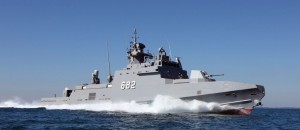
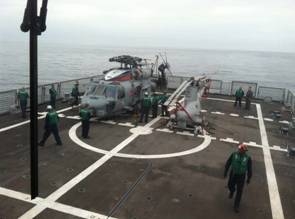
As described by Deputy Defense Secretary Bob Work in his 2013 history of the LCS program, the ship was always designed as a compromise between smaller, but less capable and globally deployable small combatants, and the larger, and more capable, but more expensive FFG-7 class frigate.1 Compared to smaller designs such as the Ambassador III or dedicated surface warfare corvettes like the Israeli Sa ar V, the LCS’ size and modularity offers advantages above those conventional small combatants. LCS’ has greater endurance then smaller missile combatants like the Ambassador (21 days verses 8) which enables it to remain at sea longer in support of surface warfare missions. The Saar V is more heavily armed then the baseline LCS seaframe, but supports only one rotary wing asset, and lacks the modularity to accommodate future sensors, weapons, and associated systems.
Both LCS seaframes, in contrast support two rotary wing assets (one MH-60R and one Firescout Unmanned Air Vehicle). The MH-60R in particular supports anti-surface and anti-submarine warfare missions, as well as extending the host ship’s sensors, weapons and communications capability far beyond those of a conventional missile combatant like the Ambassador.
The modularity of LCS also supports the embarkation of a more diverse set of capabilities than those hosted by mission-specific platforms like the Ambassador and the Saar V. An LCS might support a number of unmanned surface or subsurface vehicles separate from its Fire Scout UAV. Mines, additional munitions, and additional command and control equipment could also be supported depending on the desired mission. As the Spruance class destroyers later hosted Tomahawk cruise missiles, LCS’ modularity could support an array of heretofore undetermined systems and new capabilities in the future.
Keeping LCS Simple, but Lethal
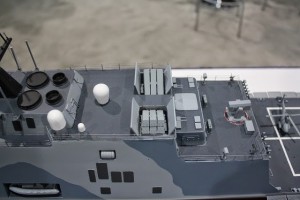
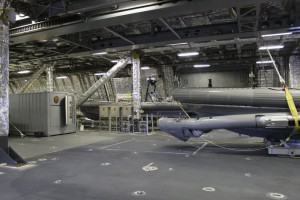
Although not presently suited to the Distributive Lethality mission, the LCS could be modified into a potent surface warfare platform with the addition of cruise missiles such as the Kongsburg/Ratheyon Naval Strike Missile. Both LCS producers (Lockheed Martin Corporation and Austal USA) have also said their respective ships could be outfitted with larger 76mm guns in place of the present 57mm weapons. While cruise missiles are a requirement for the Distributive Lethality mission, further weapons, sensors, armor and armament add little to that mission capability and increase costs which the Navy estimated to be from $60 to $75 million dollars per ship.2 This money might be better spent in additional LCS platforms as the original aim of the LCS program was to increase the size of the U.S. surface combatant fleet.
Application of additional weight for armor and warfare capabilities not related to Distributed Lethality limits the opportunity for mission package improvements in the future and could limit the number of offensive weapons the LCS can support in its current length and displacement. As reported by the GAO, LCS already has relatively tight weight ratios for further additions to the sea frames outside mission module improvements.3 Every warship is a compromise of virtues, where armament, fuel capacity, speed, survivability and other factors must be carefully balanced to achieve desired operational goals for the class. An appropriate balancing of such issues for LCS should be in favor of offensive capability to avoid the need for a costly redesign of the sea frame to support significant additions. The cost of the LCS sea frame has steadily decreased from nearly $700 million to approximately $440 million.4 Three can now be built for the cost of one DDG. This is not the time to increase the cost by redesigning the ship to fit an expanded armament. Such a process defeats the concept for making the LCS the “low” component of a new high/low mix of surface combatants.
Distribution plus Speed Equals Survival
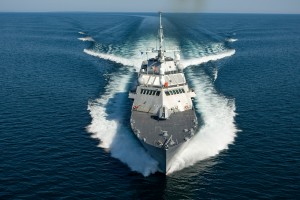
A squadron of LCS employed as part of a Distributive Lethality scheme will rely on their dispersed deployment pattern to reduce susceptibility to opponent targeting. The ships’ high speed, although often derided by critics is also a useful means of escaping enemy detection. An LCS capable of 40 knots can move away from a missile launch point faster than other U.S. combatants and potentially increase the area of uncertainty an opponent must consider in launching weapons down a return bearing.
An enemy would be forced to weigh significant risks in confronting such a force. An opponent might detect and attempt to eliminate one element of a distributive LCS force, but the remaining units might launch a devastating counter-salvo against therm. Such a response could cause significant harm to an unprepared, massed adversary force.
A basic LCS sea frame equipped with a moderate surface to surface missile capability could be a potent addition to the distributive lethality concept. Using means from fleet-wide networks to bring your own networks (BYON’s) created by groups of ships, a distributed LCS squadron operating as an anti-surface warfare (ASUW) formation could be a significant threat to opponent surface formations. The LCS’ larger size and rotary wing capabilities allow them to spend more time at sea, and see further beyond their own sensor horizon than smaller, dedicated missile combatants. LCS’s modularity allows the ships to bring additional weapons and capabilities to the fight beyond those of even heavily-armed corvettes and light frigates. These advantages suggest that LCS squadrons should be in the vanguard of the future distributed fleet.
Steve Wills is a retired surface warfare officer and a PhD student in military history at Ohio University. His focus areas are modern U.S. naval and military reorganization efforts and British naval strategy and policy from 1889-1941.
1. http://awin.aviationweek.com/Portals/AWeek/Ares/work%20white%20paper.PDF, p. 13.
2. http://www.defenseone.com/technology/2014/12/upgrades-will-let-navys-lcs-operate-more-dangerous-waters/101172/
3. http://www.gao.gov/assets/670/665114.pdf, p. 29.
4. http://news.usni.org/2015/04/01/navy-awards-2-lcss-to-austal-1-and-advance-procurement-funding-to-lockheed-martin

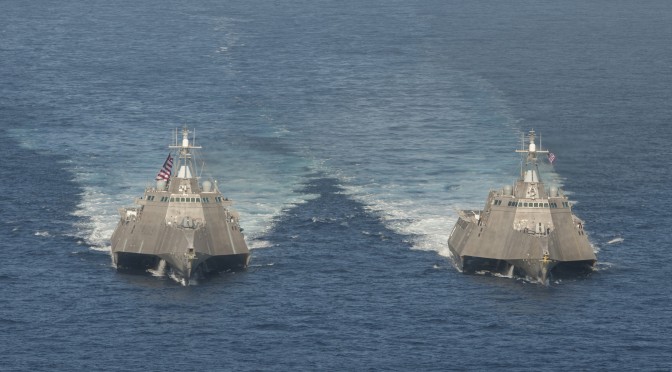
This article supports the fact that the LCS was a ship designed in numbers to increase the size of the force without adding warfighting capability. It is simply a 20th century placeholder to maintain force structure…. Numerous, responsible recommendations ((without all the “could(s)” and “can(s)”)) have been presented without any US Navy staff action. Thus, the resulting and desperate “Rowden” Distributed Lethality Concept to save the vessel. If Rowden is serious, he will put the “what” into the “it”… and get along with improving our national security infrastructure.
I would disagree. LCS does fill a warfighting role in that it is designed to perform those low end missions unfit for the DDG force and thus liberate the Burke’s for focus on high end warfare. An LCS flotilla armed with medium range ASCM’s is also a potent anti-surface warfare capability.
The term ASUW does not exist in navy or joint doctrine or terminology. surface warfare — That portion of maritime warfare in which operations are conducted to destroy or neutralize enemy naval surface forces and merchant vessels. Also called SUW. (JP 3-32)
The term ASUW exists in the USN as a concept. See here:
http://www.public.navy.mil/surfor/ddg77/Pages/departments.aspx
One piece missing from this discussion is the AAW and ISR/targeting piece. Can a flotilla of LCSs operate autonomously? Do they need area air defense from a DDG or CG to operate with acceptable risk or does that defeat the purpose of distribution? Do they (or the CRUDES) need AEW? Do they have sufficient organic ISR to find, fix, and assess targets? Are they sufficiently networked with the rest of the fleet to support OTH targeting if they don’t rely on organic sensors (Are they fully CEC capable?)?
All good questions. I would say that LCS’ best defense against air and missile attack lies in its geographic distribution, but support from other forces (air or surface) at a reasonable distance would be welcome if available. CG’s and DDG’s might be employed elsewhere and not be available. The thought is that an opponent would have to divide their ASCM firepower in order to target individual, spaced units and that this division would be deemed an unacceptable choice by an enemy seeking to launch a large salvo. It channels some of Wayne Hughes’ thinking on salvo combat, but it also depends on what the enemy’s mindset is regarding missile combat, which might not be the same as that the USN is trying to develop.
The LCS in its present condition has only basic link connections and the equivalent of an electronics “van” would need to be deployed as part of an overall surface strike “module”. They would be dependent on battle networks for ISR , but in case such connections were lost, their embarked MH-60R and/or Firescout UAV might be configured to serve as a limited ISR platform. All of this would have to come via a module, and would have to be carefully balanced with the weight of the added weapons as both LCS have significant added weight restrictions in comparison with other ships.
These were all very good points, and I agree that they would need to be worked out prior to use of LCS as a flotilla combatant. Thanks for responding!
V/r,
Steve Wills
The LCS is either too big and too expensive for coastal patrol work, or too small and lightly equipped for fleet combat.
If the LCS traded its gas turbines for bigger diesel tanks, it would make a great Coast Guard cutter for offshore patrolling and partner operations.
Alternatively, to make it a fleet combatant would require real air defense weapons (16-32 ESSMs or better). They also need either enough antisurface missiles (16+ Harpoon-size or bigger) to add a real ship-killing capability to the fleet, or increased ASW capabilities in addition to two MH-60s. Either way, it will cost lots of money (we can’t afford) and take up space the LCS designs don’t have.
I agree that LCS in its present baseline 0 form is ill-equipped to conduct distributive ASCM combat. The weapons, ISR capabilities, and other associated battle network equipment would have to come in the form a module. LCS was designed to be forwarded based and only able to move one AOR under normal conditions, so unlike a USCG WHEC, it does not need very long range. LCS could only conduct surface warfare in a flotilla, and an organization of 4-6 LCS with 8-10 ASCM’s each is enough to launch a significant networked salvo. Area air defense is a relatively futile gesture in that LCS’ best defense against ASCM attack is to remain dispersed. AN enemy that detects one such distributed LCS will have to choose whether or not to dilute their potential large salvo in order to kill one LCS. If they do that, they will immediately expose themselves to a BOL counter battery strike.
This configuration is one way the current LCS sea frame can contribute to distributive lethality.
Dispersing and hiding works if there is something to hide behind, but if there are limited number of potential contacts and free ROE, an enemy could attempt reconnaissance by fire: anything that moves gets shot again.
Also, 4-6 LCS may be able to launch significant salvo, but that would be a huge portion of the available LCS fleet, and it would be enough to either sink every major ship in the Iranian Navy, twice, or or conduct one decent attack on one of several Chinese action groups, so it is still in that ugly middle ground for capabilities.
Good points again. If an opponent attempts “reconnaissance by fire” (which they could), they would be depleting valuable ASCM stocks that would not be easily replaced in a major conflict. Agree that 6 LCS is now more than the whole operational strength of the class, but they will grow in number over time. Their salvo strength is not on par perhaps with other formations, and they would need to be used selectively. The USN does not depend on any one weapon or platform to entirely carry the fight and every operational tool, including a nominal LCS flotilla would have a part to play in a campaign at some point.
“The dispersal of the LCS flotilla complicates and dissipates enemy counter-targeting abilities.”
A few very big problems with this assertion.
1. Neither LCS appears particularly radar stealthy in terms of design. And I can only imagine how much heat its engine puts off. No way it is going to be able to hide among white shipping.
2. Given the limited operational range of LCS, significant geographic dispersion from either a logistics ship or operating base is going to be impossible. They will be tethered to something.
3. LCS has little air defense capability, which means in any sort of high-end threat environment they will need to operate close to a DDG/CG. Which again limits dispersion.
4. Given the high cost of an LCS (compared to FAC/FIACs), it is questionable the Navy will be able to procure/deploy them in large enough numbers to unduly complicate an enemy’s targeting problem.
The stealth of LCS is debatable. Bob Work says in his LCS history that stealth was given a lower priority than other elements of the LCS design. Measures might be taken to lower the LCS’ heat signature. LCS’ primary survivability trait is dispersal to the point of just being physically as remote as possible from other ships and still within an acceptable range to use its weapons. It’s dispersal complicates enemy targeting by forcing an enemy to divide his firepower. If an opponent is worried about a 3 DDG SAG that might require a 40-60 ASCM strike (totally hypothetical # not based on any known PK), will he dilute that salvo strength to kill a single LCS with say 10 ASCM’s? If he attacks one LCS, he alerts the entire battleforece network as to his whereabouts. Dispersal upsets many enemy calculations on multiple levels.
LCS has enough range to operate at low speeds distant enough from supply bases. It depends how long a CDR wants to keep the LCS force at sea. The nominal endurance remains 21 days. We can beat the horse of LCS operational range to death again, but the LCS-2 variant appears to meet the KPP for that and USS Detroit is expected to be closer to that KPP for the LCS-1 variant.
Overloading LCS with additional air defense really does not improve its survivability. Such additions will limit the ship’s offensive capability. Additional soft kill measures may be embarked aboard with less weight than even a limited SAM system. The fleet may not have enough DDG’s to cover the LCS force and I have assumed they will have to operate on their own. The real question is whether or not an opponent will want to denude their salvo capabilities in order to kill isolated LCS units. I am betting that they will not want to blow their chance to sink the CSG by killing a few LCS. The LCS flotilla, however, remains capable of launching a significant salvo and remains a threat if the enemy does not promptly deal with its presence. Either we, the USN forces an opponent to make unpopular choices.
30 dispersed LCS with 180 to 240 ASCM’s aboard complicates an enemy targeting problem by forcing the enemy to deal with the threat they pose. That could mean expending 10 to 12 ASCM’s per LCS to ensure they are killed. That’s 300-360 ASCM’s that could have been fired at CSG units. ASCM stocks will be a precious commodity that nations will not want to expend if they do not have to, and forcing them to expend their arsenals against isolated targets certainly complicates their decision-making process.
I don’t know why I bother, but I’ll point out once again that you are failing to distinguish between the LCS concept, actual validated requirements, and demonstrated capabilities. In terms of range:
– Concept: 21 days at sea.
– Requirement: 3,500 nm at 14 kts. 11 days at sea.
– Demonstrated: LCS-3 was 1,961 nm at 14 kts. 5.5 days at sea.
I tend to think distributed lethality as an offshoot of Wayne Hughes’s salvo equation. Not a bad idea in principal. The problem is trying to implement it with a corvette (LCS) that will cost upward of $500 million and carry a crew of around 90.
If you look at Red’s side of the equation, a KLUB anti-ship missile can be bought from Russia for around $6 million. This is based on India’s attempted purchase of 28 missiles for $184 million in 2007.
So If it takes Red ten missiles to put an LCS out of action, the net cost to Red would be $60 million. Note that ten missiles per kill is extremely conservative when one looks at Falklands, actions in Med and Gulf, etc. But let’s go with it.
Compare this $60 million cost to Red to $500 million and 90 sailors lost for Blue. Which side of the equation would you want to be on?
The salvo equations work if you have enough ships present and dispersed to make it hard for Red to target and take you out on the first salvo. In that respect, LCS is a triple loser:
1. It’s far too expensive to be acquired/deployed in mass.
2. It lacks the range to conduct true dispersed operations.
3. It’s ability to hide is questionable. Stealth wasn’t a priority.
If COMNAVSURFOR truly believes in the salvo equations, it should invest in many small, cheap, expendable fast attack craft (FAC). Ten ASCM armed FACs at $50 million apiece are a lot harder targeting problem than one LCS at $500 million.
The LCS concept is changing in response to a change in geopolitical conditions. The world is not as it was when LCS was conceived. The proposal for LCS to become a distributed lethality combatant is just that: a proposal that would need to be validated. I don’t know why I bother, but I will again say that your figures come from one DOTE&E evaluation of one of four potential LCS variants (2 baseline LCS and 2 FF versions). One test is not enough to dismiss the entire concept.
As to cost, it depends on how many ASCM’s any Red has in stock on day one of a war. Resupply may be very challenging. The 3M-54 is a sub-launched missile and may not be able to be launched in a coordinated salvo. Your financial equation on paper may not mirror reality so exactly. Additional wargaming on the concept is needed.
LCS is currently coming in at $440 million a copy. The FAC concept has been largely rejected by the USN since its boats are operationally and strategically imprisoned in their resident AOR. LCS, as Bob Work says, grew in response to a requirement for self deployability. It is unlikely that the USN will revisit small missile craft in the near future.
Finally, I totally disagree that LCS is any kind of “triple loser” for distributed lethality and it looks like SURFOR agrees:
http://news.usni.org/2015/07/09/navy-studying-implications-of-distributed-lethality-in-wargames-series
Lazarus. You are entitled to your opinions. You are not entitled to the facts.
Endurance. The LCS CDD requirement works out to 11 days underway. Not 21. And in the one test, LCS-3 missed the 11 day requirement by a very wide margin. Unless you have real data, discussion on the range/endurance of the other variants is just guesswork. DOT&E has no published test data for LCS-2, and the proposed LCS/FF variants are about as real as a PowerPoint slide.
Threats. The 3M-54 has both surface and sub launched variants (KLUB-N and KLUB-S). China has also developed an indigenous variant (YJ-18). They also have developed a fairly capable air-launched cruise missile (YJ-12). The YJ-8 has equipped their destroyers since the ‘90s. And if the fight is against China in their backyard., I wouldn’t count on them running out of missiles.
Cost. The Navy’s FY16 budget requested $1.473B to procure three LCS seaframes. This works out to a unit cost of $476M. Seaframe only. Not mission package. So basically an LCS with minimal mission capability already costs more than $440M.
The average unit price of each of the 59 mission packages is $68M. Adding the cost of the seaframe to the cost of the mission package yields $476M + $68M = $544M. Source for all of the cost data is Navy LCS/Frigate Program: Background and Issues for Congress, Ronald O’Rourke, June 12 2015.
Note that the report states that there is zero data on what the FF variant will cost. I’d hazard it won’t drive the costs down. In the end, we’ll still be looking at a relatively low capability covette that is about 10x more expensive than the salvo of ASCMs used to kill it.
Of course SURFOR disagrees that LCS is a “triple loser”! He’s staked his reputation on LCS. I am beginning to suspect that “Distributed Lethality” is just a smokescreen to deflect steady criticism of LCS. Just a little more funding and CONOPS changes and it will all work. Trust us.
We will then agree to disagree across a wide range of issues.
Reasonable men can agree to disagree on opinions. Not facts. I would like to know:
How do you stand by a unit cost of $440M when even the Navy’s budget numbers don’t support this?
How do you stand by a “notional 21-day endurance” when the only test point says that LCS achieved about 5.5 days?
Either provide sources or I’ll assume it’s hope and pixie dust.
Error on my part. The June 12th CRS report states that Navy’s FY16 request was $1.437B for three LCS.
This works out to an average cost of $479M per seaframe – vice the $476M that I typed. Again – not including mission packages.
Adding the $68M average cost of mission packages brings this to a unit cost of $547M. Only about $100M more than the figure you cited!
The $440 million figure is from the Feb 9th CRS report (RL33741). It’s not wrong, just old.
Perhaps wrong is an overstatement. However, the $39 million delta is significant
Citing seafrane cost is also a bit misleading in that it does not account for the (non-trivial) cost of developing and procuring mission packages.
Bottom line: a “fully-capable” LCS is going to cost more than $500 million.
Ok, so you are hung up on the cost. I agree that the Navy egregiously underestimated the original cost of the LCS sea frame. Bob Work agrees in his LCS history and suggests that $445 to $529 million would have been a better estimate. The FFG was terribly underpriced as well in its infancy and grew from an estimate of $64 million in 1973 to $194 million in 1979.
http://archive.gao.gov/f0302/108301.pdf
PEO management of LCS has done a good job in driving down costs. We cannot get back the years 2003-2010. Navy and Defense acquisition in general need substantial overhaul. Dwelling on the past, however, is no way to move forward. Work’s figures (from the very respected Dr. Eric Labs) and those presented in a 2006 RAND report on the hight cost of surface ships suggest that the present US defense industry is not going to build a “frigate” (like the European version) for under a billion dollars. Lars Hanson and others who suggest it can should read these documents. The Australians have had this problem in building the Hobart.
Complaining about the cost of one platform is like shouting at the clouds.
I am not ‘hung up’ on cost, but will address it since you brought it up.
I’ve read the RAND report and fully recognize that shipbuilding costs are accelerating faster than inflation. But that’s a poor excuse for the programattic incompetence exhibited by LCS.
LCS will cost what it costs. Right now that appears to be above $500 million a unit (seaframe + mission packages). Do you dispute this value or not?
I don’t think we could’ve had a ‘true’ frigate any cheaper than this. $1 billion seems about right. However, we certainly could’ve bought a lot of dedicated MCM vessel or PCs for a lot cheaper than $500 million and banked the savings towards a purpose designed frigate.
Instead the Navy tried to cram three very different missions (ASW, counter-FAC, and MIW) into one family of seaframes. At the time, I thought this was/is the height of idiocy. But then trying to bang the LCS to fill a frigate-sized hole in the Fleet? I’m both awed and stupefied.
Switching gears, what I am hung up on analysis based on faulty/misaligned/cherry-picked information. This is especially galling coming from someone who claims to be pursing a PhD. The methods class I took during my masters program emphasized that data sources are everything.
I’ve especially noticed in your posts on LCS that the data sources tend to be an odd, indistinguishable mish-mash of:
a. Concepts (PowerPoint slides from early 00’s)
b. Requirements (what Navy actually asked for)
c. Performance (empirical data on what Navy is getting)
Do yourself a favor. Put together a spreadsheet.
The rows are all the key traits of LCS. Cost, schedule, manpower, and performance. The latter should include range, endurance, weapons, sensors,
The columns would be data sources: LCS concept, CDD requirements, and real-world performance.
Once you’ve done that – throw away anything associated with the LCS concept. Then take a hard hard look at how CDD requirements match real-world performance.
I do not dispute that the LCS program was not well managed in the years before it was put under PEO management. The concept, however, remains sound in my opinion. Small, dedicated, single mission warships have never fared well over time in the US Navy. Mine warfare and patrol ships are usually last on the funding and maintenance list. I know; I served on both classes. Putting these functions together on a larger ship that will command greater funding and attention is a positive step. We obviously disagree on the definition of what a “frigate” is. The sort of “destroyer light” that you seem to favor is obsolete in the present threat environment and too expensive for the limited set of capabilities in provides. The large frigate was a product of Cold War requirements, but not so in the present and immediate future. LCS
The surface fleet’s force structure is very different from what it was in the Cold War. The relative strength of large, capable ships is much greater than in the past. The baseline 0 (Sea frame) LCS (even at the Congressional Cost Cap of $535 million) is fully capable of conducting the low end missions sustained by the Perry’s in their final years. One DOT&E test is not enough to label KPP’s unmet. I agree that making the LCS a flotilla missile combatant will cost additional funds, but it seems a choice worth making strategically if the US Navy wants to increase the number of self-deployable assets capable of surface combat.
But, I suppose we will continue to disagree.
ASUW was rejected as a navy term about a decade ago. See https://ndls.nwdc.navy.mil/Default.aspx. When you take “Anti” and apply it to the definition of SUW you get: “That portion of maritime warfare in which operations are NOT conducted to destroy or neutralize enemy naval surface forces and merchant vessels.”
Regarding the website referenced, one notices the term AAW, which does not exist either. I refer you to the OPNAV ROC/POE INST C3501.2 that list USN mission areas chapter 1, page 1-1.